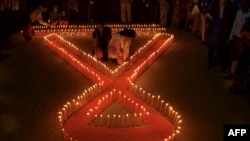A U.N. Children’s Fund (UNICEF) report backed by two years of research says increasing HIV infections among adolescents has triggered alarms of a new epidemic.
The researchers warn that Asia Pacific nations in particular are facing a sharp rise in the incidence of HIV among adolescents, especially among key populations in urban centers, marking a worrying step back at a time when the global incidence of HIV has been falling.
Wing-Sie Cheng, a regional UNICEF adviser on HIV and AIDS, says the cause for concern lies with the dramatic 120 percent increase in deaths among adolescents since 2000.
“Asia Pacific is facing a hidden epidemic of HIV among teenagers and it is hidden because testing cannot really be put on teenage people under the age of 18, primarily because there’s a guideline that they have to obtain parental consent,” he said.
While the vast majority of people under the age of 20 are at low risk for HIV, prevalence is reaching double digits among key adolescent populations in Hanoi, Bangkok, Chiang Mai, Mumbai and cities in China.
Cambodia, China, India, Myanmar, Pakistan, Papua New Guinea, the Philippines and Vietnam are where the HIV burden among adolescents is most significant.
According to the study, the number of adolescents living with HIV in Indonesia has reached more than 40,000, followed by Thailand at almost 10,000.
Across the region the U.N. says there are around 220,000 adolescents altogether living with HIV.
Wing-Sie Cheng says the trend points to an epidemic among the adolescent age group in new infections.
“[The] 50,000 number tells you that there is an epidemic among this age group," she said. "So therefore the challenge is really to get governments to really come up with adolescent sensitive response to this group.”
The report is calling on governments to develop better data on adolescents, strategies for HIV prevention and adolescent-specific laws and policies. The report adds that just 10 countries in the region have laws and policies that enable independent consent for young people to access HIV testing and other services.









